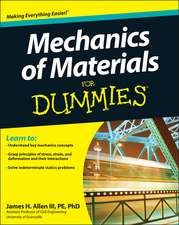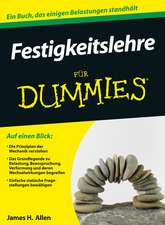Statics For Dummies
Autor JH Allenen Limba Engleză Paperback – 2 sep 2010
Preț: 123.66 lei
Nou
Puncte Express: 185
Preț estimativ în valută:
23.67€ • 24.39$ • 19.98£
23.67€ • 24.39$ • 19.98£
Carte disponibilă
Livrare economică 10-24 februarie
Livrare express 25-31 ianuarie pentru 37.99 lei
Preluare comenzi: 021 569.72.76
Specificații
ISBN-13: 9780470598948
ISBN-10: 0470598948
Pagini: 384
Dimensiuni: 187 x 235 x 27 mm
Greutate: 0.68 kg
Editura: Wiley
Locul publicării:Hoboken, United States
ISBN-10: 0470598948
Pagini: 384
Dimensiuni: 187 x 235 x 27 mm
Greutate: 0.68 kg
Editura: Wiley
Locul publicării:Hoboken, United States
Public țintă
The primary audience includes undergraduate students taking a Statics and currently enrolled in a Mechanical or Structural Engineering course of study. This book will also be a great resource for Architecture students who must also be well versed in the principles of statics.Notă biografică
James H. Allen III, PE, PhD, is a registered professional engineer who teaches courses in the areas of statics, mechanics, structural engineering, and steel design.
Descriere scurtă
Cuprins
Introduction. Part I: Setting the Stage for Statics. Chapter 1: Using Statics to Describe the World around You. Chapter 2: A Quick Mathematics Refresher. Chapter 3: Working with Unit Systems and Constants. Part II: Your Statics Foundation: Vector Basics. Chapter 4: Viewing the World through Vectors. Chapter 5: Using Vectors to Better Define Direction. Chapter 6: Vector Mathematics and Identities. Chapter 7: Turning Multiple Vectors into a Single Vector Resultant. Chapter 8: Breaking Down a Vector into Components. Part III: Forces and Moments as Vectors. Chapter 9: Applying Concentrated Forces and External Point Loads. Chapter 10: Spreading It Out: Understanding Distributed Loads. Chapter 11: Finding the Centers of Objects and Regions. Chapter 12: Special Occasions in the Life of a Force Vector: Moments and Couples. Part IV: A Picture Is Worth a Thousand Words (Or At Least a Few Equations): Free-Body Diagrams. Chapter 13: Anatomy of a Free-Body Diagram. Chapter 14: The F.B.D.: Knowing What to Draw and How to Draw It. Chapter 15: Simplifying a Free-Body Diagram. Part V: A Question of Balance: Equilibrium. Chapter 16: Mr. Newton Has Entered the Building: The Basics of Equilibrium. Chapter 17: Taking a Closer Look at Two-Dimensional Equilibrium: Scalar Methods. Chapter 18: Getting Better Acquainted with Three-Dimensional Equilibrium: Vector Methods. Part VI: Statics in Action. Chapter 19: Working with Trusses. Chapter 20: Analyzing Beams and Bending Members. Chapter 21: Working with Frames and Machines. Chapter 22: A Different Kind of Axial System: Cable Systems. Chapter 23: Those Darn Dam Problems: Submerged Surfaces. Chapter 24: Incorporating Friction into Your Applications. Part VII: The Part of Tens. Chapter 25: Ten Steps to Solving Any Statics Problem. Chapter 26: Ten Tips for Surviving a Statics Exam. Index.













